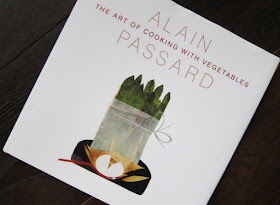 |
| The Art of Cooking with Vegetables Alain Passard |
Some time in the 1990's I was lucky enough to eat at L'Arpege in Paris. Dish after sublime dish passed from kitchen to table. I remember every plateful being simple but wonderful with, mercifully, none of the primping and tweaking one might have expected. But it was the end of the meal which I remember best. Yes, Passard did make an appearance, in a self-effacing way but what has stayed with me was the way a basket containing a whole tray of exquisite baby madeleines, hot from the oven, was placed before us. It was a nice touch which left us feeling like we had dined with friends rather than at a Michelin starred restaurant, albeit we had paid for the privilege.
In 2000 Alain Passard, shockingly, removed red meat from his restaurant menu. A brave move from a man who had worked hard to gain no less than 3 Michelin stars. I haven't eaten at L'Arpege since the change in focus, but it does still have those 3 stars. All the vegetables used in the restaurant are grown on Passard's biodynamic farm south-west of Paris. As I grow biodynamically myself, I probably appreciate his enthusiasm more than most. His passion to unite a love of cooking with that of art took him on a "quest for gastronomic and visual harmony" and The Art of Cooking with Vegetables, is published for the 25th anniversary of L'Arpege.
Vegetarians will love this book for its unusual and interesting pairings. It's so different, with not a grain of quinoa in sight, that I can see it appealing to the most committed meat eater too. It takes vegetables seriously and, in 48 seasonal recipes, places them centre stage. Despite the title, there are a few recipes for fruit too. Personally, I love the colourful collage representations alongside the recipes but if you prefer to see clearly what you're aiming for you may not share my enthusiasm. Having been given this book as a present, I opened it a little nervously thinking my cooking couldn't possibly live up to the recipes within. In fact the recipes are very simple and in the case of the two I've tried so far, you really can't go wrong. Both were visually impressive and delivered on taste, just as promised, so I'm keen to work my way through the book season by season. Alain Passard would like his readers to be "a cook and an artist" and with recipes like these, how can we fail.
Published by Frances Lincoln Limited









